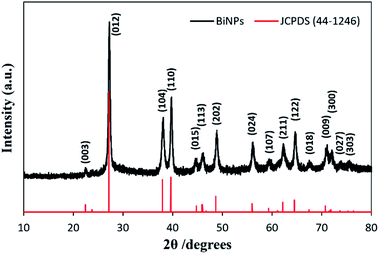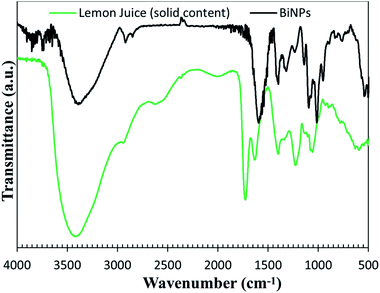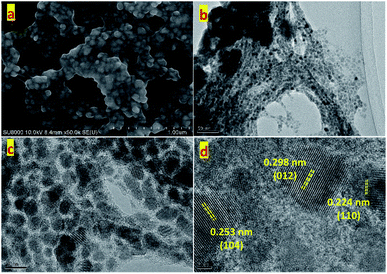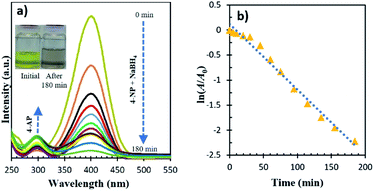 Open Access Article
Open Access ArticleGreen synthesis of crystalline bismuth nanoparticles using lemon juice†
Md. Mahiuddin and
Bungo Ochiai
and
Bungo Ochiai *
*
Department of Chemistry and Chemical Engineering, Graduate School of Science and Engineering, Yamagata University, Jonan 4-3-16, Yonezawa, Yamagata 992-8510, Japan. E-mail: ochiai@yz.yamagata-u.ac.jp; Fax: +81-238-26-3092; Tel: +81-238-26-3092
First published on 4th August 2021
Abstract
Lemon juice effectively served as a reducing and capping agent for an easy, cost-effective, and green synthesis of crystalline bismuth nanoparticles (BiNPs) in basic aqueous media. Spherical BiNPs with a rhombohedral crystalline structure are capped by phytochemicals and stably dispersible in aqueous media. The BiNPs effectively catalyze the reduction of 4-nitrophenol to 4-aminophenol by NaBH4.
Nanostructures of bismuth, the heaviest element among the ‘safe ones’ earning the status of a ‘green element’,1 are particularly interesting due to their large magnetoresistance and excellent thermoelectric properties.2–4 Bismuth nanoparticles (BiNPs) are the most extensively used nanostructures of bismuth. For example, BiNPs are utilized as contrast agents for computed tomography, photoacoustic imaging and infrared thermal imaging,5,6 catalysts for the reduction of nitroaromatic compounds,7,8 and removal of NO from air.9 Furthermore, BiNPs can act as intermediates for the synthesis of other nanostructures of bismuth, such as thermoelectric Bi2Te3 (ref. 10) and seeds for the solution–liquid–solid growth of nanowires.11,12 Techniques for the synthesis of pure BiNPs could be categorized into (i) thermal decomposition,12 (ii) mechanochemical processing,13 (iii) photochemical reduction,14 and (iv) solution-phase chemical reduction methods.6,15–19 The thermal decomposition method requires harsh preparation conditions, expensive organometallic precursors, high temperature, and long reaction time, while producing high-quality monodispersed BiNPs. The mechanochemical processing technique is advantageous in terms of using inexpensive and nontoxic bulk bismuth pellets as precursors. However, the energy consumption and costly instrumentations are the limitations. The photochemical reactions typically require long time for sufficient conversion to bismuth nanoparticles, while they can also produce highly monodispersed BiNPs. The solution-phase chemical reduction methods are most popular due to the facile procedures and accessible reagents. However, stabilizers and toxic reducing agents often used are the limitations. To resolve the above-mentioned limitations, simple and green alternative methods are highly demanded.
The use of abundant plant sources, which has been applied for synthesis of various metal nanoparticles such as Ag and Au, is a promising solution.20,21 Plant sources contain a wide variety of biomolecules potentially serving as reducing and capping agents. Edible plant sources are obviously safest. To the best of our knowledge, there is no report on the synthesis of crystalline BiNPs using plant sources, while P. Poltronieri et al. reported synthesis of amorphous BiNPs using hydroalcoholic extract of Moringa oleifera.22 We focused on lemon, a very common fruit containing abundant antioxidants such as polyphenols, limonoids, citric acid, ascorbic acid, and vitamins potentially reduce ions with high oxidation states. Some of the phytochemicals, namely carbohydrates and proteins bearing ionic moieties, can be capping agents. Accordingly, lemon juice was successfully applied for the formation and in situ stabilization of silver and gold nanoparticles in aqueous media.23,24 We presumed that a similar mechanism also works for BiNPs.
In this communication, we introduce a greener strategy for the synthesis of crystalline BiNPs using lemon juice as a reducing and capping agent. For example, the synthesis was carried out using Bi(NO3)3·5H2O (0.25 mmol) and freshly prepared lemon juice (25 mL) at 80 °C for 2 h under an aerobic basic condition. The X-ray diffraction (XRD) pattern (Fig. 1) of the obtained product was indexed to the pure rhombohedral phase of elemental bismuth (JCPDS no. 44-1246), indicating that the obtained product is BiNPs without detectable oxide phases. The average crystallite size was calculated to be 20 nm applying the Scherrer's equation on the peaks of the (012), (104) and (110) plane. This result indicates that the phytochemicals present in lemon juice have ability to reduce bismuth salts to form BiNPs. The plausible phytochemicals for reduction are ascorbic acid, citric acid, and sugars. The reduction of Bi3+ with glucose8 and ascorbic acid17 was reported, and we accordingly performed the control experiment using possible reducing agents contained in lemon juice, namely ascorbic acid, glucose, and starch without any stabilizing agents. All of them could form elemental bismuth in highly aggregated forms as confirmed by the XRD patterns (ESI, Fig. S9†) and SEM images (ESI, Fig. S10†).
 | ||
| Fig. 1 XRD pattern of obtained BiNPs synthesized using lemon juice with that of authentic Bi (JCPDS no. 44-1246). | ||
Electron microscopy was employed to confirm the size and the morphology of synthesized BiNPs. The scanning electron micrography (SEM) image (Fig. 2a) shows spherical objects having the size in the range of 50 to 100 nm agglomerated and covered with amorphous substances presumably originating from lemon juice. This agglomeration occurred during drying as confirmed by the stable water dispersibility of BiNPs with an average hydrodynamic diameter (Dh) of 255 nm investigated by dynamic light scattering (DLS) (ESI, Fig. S1a†). The high colloidal dispersibility of the BiNPs and the coating layer observed in the SEM image suggest that phytochemicals present in lemon juice act also as capping agents. The larger Dh measured by DLS than the size observed by SEM can be attributed to the surrounding hydration layer and swelled phytochemicals attached to the surface of the BiNPs. We then performed transmission electron microscopy (TEM) analysis to get the actual size of the Bi cores. The TEM images of the BiNPs (Fig. 2b and c) indicated the presence of heavy elements in the matrix of light elements. The particles are spherical, and the diameter ranges from 8 to 30 nm. The high-resolution TEM image (Fig. 2d) shows the lattice fringes of 0.298 nm, 0.253 nm, and 0.224 nm of the typical crystallite agreeing well with the distance of the (012), (104) and (110) plane, respectively, of the rhombohedral Bi(0).
The EDX spectrum (ESI, Fig. S2†) reveals that obtained BiNPs comprise bismuth (Bi), carbon (C), and oxygen (O). The strongest signal of bismuth testifies the successful synthesis of BiNPs, whereas the C and O signals demonstrate the presence of the capping layer on the BiNPs.
The FT-IR spectrum of the synthesized BiNPs was analyzed to presume the possible components on the BiNPs surface with the comparison with the solid content of lemon juice (Fig. 3). The FT-IR spectrum of the BiNPs shows the following major absorption bands. The broad absorption band at 3050–3500 cm−1 is assignable to the O–H stretching of alcohol moieties. The absorption band around 2840–2940 cm−1 is assignable to the C–H stretching of alkane, and the absence of the sharp absorption around 2950–3050 cm−1 suggests the absence of trace contents of unsaturated C–H groups. The absence of the adsorptions originating from COO–H around 2400–3100 cm−1 and C![[double bond, length as m-dash]](https://www.rsc.org/images/entities/char_e001.gif) O around 1700–1730 cm−1 indicates that citric acid25,26 and other carboxylic acids contained sufficiently in lemon juice are not the major components on the BiNPs, while the presence of the strong absorption around 1600 cm−1 is assignable to carboxylate moieties. The absorption bands around 930–1130 cm−1 assignable to C–C and C–O stretching and around 1200–1420 cm−1 assignable to O–C–H, C–C–H and C–O–H bending suggest the presence of sugars on BiNPs.25,26 The content of the organic moieties was estimated approximately 14% by thermogravimetric analysis from weight loss that occurred at the temperature range from 130 to 450 °C (ESI, Fig. S3†), at which the negligible C and O signals were observed in the EDX spectrum of the residue after TGA (ESI, Fig. S2†).
O around 1700–1730 cm−1 indicates that citric acid25,26 and other carboxylic acids contained sufficiently in lemon juice are not the major components on the BiNPs, while the presence of the strong absorption around 1600 cm−1 is assignable to carboxylate moieties. The absorption bands around 930–1130 cm−1 assignable to C–C and C–O stretching and around 1200–1420 cm−1 assignable to O–C–H, C–C–H and C–O–H bending suggest the presence of sugars on BiNPs.25,26 The content of the organic moieties was estimated approximately 14% by thermogravimetric analysis from weight loss that occurred at the temperature range from 130 to 450 °C (ESI, Fig. S3†), at which the negligible C and O signals were observed in the EDX spectrum of the residue after TGA (ESI, Fig. S2†).
 | ||
| Fig. 3 FT-IR spectra of solid content of lemon juice and obtained BiNPs synthesized using lemon juice. | ||
The 1H and 13C NMR and FTIR spectroscopic analysis (ESI, Fig. S4–S8†) of the ethanol and chloroform extracts of the BiNPs suggests that the major capping phytochemicals are polysaccharides and fatty acid derivatives. Other minor possible components may include amino acids, terpenes and phenolic compounds contained in lemon juice.
The successful formation of BiNPs made us enthusiastic to investigate their catalytic performance in the reduction of nitroaromatic compounds, problematic pollutants arising from explosives, analgesic, and antipyretic drugs and dyes.27 Herein, the catalytic performance of our BiNPs was investigated by selecting the reduction of 4-nitrophenol (4-NP) to 4-aminophenol (4-AP) by NaBH4 at room temperature as a model reaction.7,8,28 The progress of the reduction was monitored by UV-vis absorption spectroscopy. The colour of the 4-NP aqueous solution changed from light yellow to deep yellow upon the addition of NaBH4 to produce 4-nitrophenolate ion and an intense absorption peak at 403 nm appeared instead of the original absorption peak of 4-NP at 316 nm in the UV-vis spectrum.7 In the absence of BiNPs, the colour of the solution and the intensity of the peak were retained even after 12 h. In the presence of BiNPs, the deep yellow mixture became almost colourless within 180 min (Fig. 4a). The intensity of the absorption peak at 403 nm decreased overtime, and simultaneously a new absorption peak appeared and grew at 299 nm, indicating the formation of 4-AP (Fig. 4a).8,27,29 The reaction rate almost follows pseudo-first-order kinetics agreeing with the Langmuir–Hinshelwood mechanism; in which two reactants react after adsorption on the solid surface, and then the product desorbs. The rate constant (k) was determined from the plot of ln(A/A0) vs. time (Fig. 4b) according to the previous reports.7,8,28,29 The k value of 0.0134 min−1 (activity factor = 0.1 s−1 g−1) is lower than previously reported PVP-coated bismuth nanodots (6.033 s−1 g−1)8 and starch coated BiNPs (0.02751 s−1).7 The lower catalytic rate of our BiNPs can be attributed to the electrostatic repulsion of 4-nitrophenolate ions with negatively charged BiNPs (zeta potential value = −31.7 mV) in the reaction mixture. The initial rate is slower than the rate after 50 min. Possible factors are (i) the inductive period for the surface activation of the nanoparticles at the initial stage as reported for bismuth nanodots by Liang et al.8 and (ii) partial and gradual release of phytochemicals under the basic conditions. After the catalytic reaction, the Dh value measured by DLS (195 nm) became smaller than the original one maintaining the good water dispersibility, suggesting unravelling of primary particles fused by the capping layer (ESI, Fig. S1b†). In addition, the weight loss in the TGA curve became lower (ESI, Fig. S3†), and the SEM image implies the partial loss of the coating (ESI, Fig. S11†). This decrease of the organic moieties is attributable to the partial removal of coating substances such as fatty acids during the catalytic reaction under the basic and reductive conditions, supported by the disappearance of the absorption band around 1600 cm−1 assignable to carboxylate moieties in the FTIR spectrum of BiNPs after the catalytic reaction (ESI, Fig. S12†). Carboxylic acids and their esters are reported to be reduced to alcohol by NaBH4 in the presence of electrophiles.30–33 The initial presence of the amphiphilic and anionic layer plausibly delays the catalytic reaction.
In conclusion, we have demonstrated a green, cost-effective, and successful approach for synthesis of crystalline BiNPs using lemon juice as a reducing as well as capping agent. The obtained BiNPs effectively catalysed the reduction of 4-NP to 4-AP by NaBH4. The importance of this method lies in the simple synthetic procedure, uses of safe and low-cost lemon, and good dispersibility over conventional chemical approaches.
Experimental
(a) Collection of lemon juice
Yellow lemon was purchased from a supermarket in Yonezawa city of Yamagata prefecture, Japan, and thoroughly washed with deionized distilled water. The juice was collected through squeezing the lemon followed by centrifugation and filtration, and finally stored at 4 °C for further use.(b) Synthesis of BiNPs
Bi(NO3)3·5H2O (121.3 mg, 0.25 mmol) was mixed with lemon juice (25.0 mL) by sonicating ca. 20 min. Then, the pH was adjusted to 12.3–12.4 using 4 M aqueous NaOH (3.5–4.0 mL) and the mixture was stirred at 80 °C for 2 h in a thermostat bath. The initial yellow transparent solution turned into dark red and finally became a black dispersion. The dispersion was cooled at room temperature with constant stirring. The black product was collected by centrifugation at 8000 rpm for 10 min, washed with water several times, and vacuum-dried at 65 °C for 12 h (yield = 83.2%). No black product was obtained at lower temperature and lower pH (details in ESI†).(c) Catalytic reduction
The catalytic reduction was carried out by mixing an aqueous solution of 4-NP (22 ppm, 25 mL), NaBH4 (20 mM, 7.5 mL), and the colloidal dispersion of BiNPs (1 mg mL−1, 2.5 mL) at 25 °C. The conversion of 4-NP to 4-AP was monitored by UV-vis spectroscopy.Author contributions
MM: conceptualization, methodology, investigation, data curation, writing – original draft. BO: conceptualization, supervision, writing – review & Editing.Conflicts of interest
There are no conflicts to declare.Acknowledgements
MM acknowledges the Ministry of Education, Culture, Sports, Science and Technology, Japan, for providing the Japanese Government (Monbukagakusho: MEXT) Scholarship.Notes and references
- R. Mohan, Nat. Chem., 2010, 2, 336 CrossRef CAS PubMed.
- J. Fang, K. L. Stokes, W. L. Zhou, J. Lin and W. Wang, Chem. Commun., 2001, 1, 1872–1873 RSC.
- H. Liu and Z. L. Wang, J. Am. Chem. Soc., 2005, 127, 15322–15326 CrossRef CAS PubMed.
- Y. Wang, J. Zhao, X. Zhao, L. Tang, Y. Li and Z. Wang, Mater. Res. Bull., 2009, 44, 220–223 CrossRef CAS.
- A. L. Brown and A. M. Goforth, Chem. Mater., 2012, 24, 1599–1605 CrossRef CAS.
- A. L. Brown, P. C. Naha, V. Benavides-Montes, H. I. Litt, A. M. Goforth and D. P. Cormode, Chem. Mater., 2014, 26, 2266–2274 CrossRef CAS PubMed.
- F. Xia, X. Xu, X. Li, L. Zhang, L. Zhang, H. Qiu, W. Wang, Y. Liu and J. Gao, Ind. Eng. Chem. Res., 2014, 53, 10576–10582 CrossRef CAS.
- Y. Liang, J. Manioudakis, J.-R. Macairan, M. S. Askari, P. Forgione and R. Naccache, ACS Omega, 2019, 4, 14955–14961 CrossRef CAS.
- F. Dong, T. Xiong, Y. Sun, Z. Zhao, Y. Zhou, X. Feng and Z. Wu, Chem. Commun., 2014, 50, 10386–10389 RSC.
- M. Scheele, N. Oeschler, K. Meier, A. Kornowski, C. Klinke and H. Weller, Adv. Funct. Mater., 2009, 19, 3476–3483 CrossRef CAS.
- F. Wang and W. E. Buhro, Small, 2010, 6, 573–581 CrossRef CAS.
- M. Yarema, M. V. Kovalenko, G. Hesser, D. V. Talapin and W. Heiss, J. Am. Chem. Soc., 2010, 132, 15158–15159 CrossRef CAS PubMed.
- R. K. Verma, K. Kumar and S. B. Rai, J. Colloid Interface Sci., 2013, 390, 11–16 CrossRef CAS PubMed.
- S. C. Warren, A. C. Jackson, Z. D. Cater-Cyker, F. J. DiSalvo and U. Wiesner, J. Am. Chem. Soc., 2007, 129, 10072–10073 CrossRef CAS.
- P. Lei, R. An, P. Zhang, S. Yao, S. Song, L. Dong, X. Xu, K. Du, J. Feng and H. Zhang, Adv. Funct. Mater., 2017, 27, 1–10 Search PubMed.
- J. S. Son, K. Park, M.-K. Han, C. Kang, S.-G. Park, J.-H. Kim, W. Kim, S.-J. Kim and T. Hyeon, Angew. Chem., Int. Ed., 2011, 50, 1363–1366 CrossRef CAS.
- R. Fu, S. Xu, Y.-N. Lu and J.-J. Zhu, Cryst. Growth Des., 2005, 5, 1379–1385 CrossRef CAS.
- R. Vazquez-Munoz, M. J. Arellano-Jimenez and J. L. Lopez-Ribot, MethodsX, 2020, 7, 100894 CrossRef PubMed.
- Y. Wang and K. S. Kim, Nanotechnology, 2008, 19, 265303 CrossRef.
- N. A. Begum, S. Mondal, S. Basu, R. A. Laskar and D. Mandal, Colloids Surf., B, 2009, 71, 113–118 CrossRef CAS PubMed.
- S. Iravani, Green Chem., 2011, 13, 2638 RSC.
- P. E. Das, A. F. Majdalawieh, I. A. Abu-Yousef, S. Narasimhan and P. Poltronieri, Materials, 2020, 13, 876 CrossRef CAS PubMed.
- P. Mosae Selvakumar, C. A. Antonyraj, R. Babu, A. Dakhsinamurthy, N. Manikandan and A. Palanivel, Synth. React. Inorg., Met.-Org., Nano-Met. Chem., 2016, 46, 291–294 CrossRef CAS.
- M. V. Sujitha and S. Kannan, Spectrochim. Acta, Part A, 2013, 102, 15–23 CrossRef CAS.
- C. Clark, N. Z. J. Crop Hortic. Sci., 2016, 44, 69–82 CrossRef CAS.
- T. Ajayeoba, O. Atanda, A. Obadina, M. Bankole and S. Brumbley, LWT–Food Sci. Technol., 2016, 74, 534–541 CrossRef CAS.
- R. D. Neal, Y. Inoue, R. A. Hughes and S. Neretina, J. Phys. Chem. C, 2019, 123, 12894–12901 CAS.
- N. Li, J. Ming, M. Ling, K.-L. Wu, Y. Ye and X.-W. Wei, Chem. Lett., 2020, 49, 318–322 CrossRef CAS.
- K. Wu, X.-Y. Wang, L.-L. Guo, Y.-J. Xu, L. Zhou, Z.-Y. Lyu, K.-Y. Liu, R. Si, Y.-W. Zhang, L.-D. Sun and C.-H. Yan, Nano Res., 2020, 13, 2044–2055 CrossRef CAS.
- J. V. B. Kanth and M. Periasamy, J. Org. Chem., 1991, 56, 5964–5965 CrossRef CAS.
- Y. R. Rao, A. J. Pantulu and G. Lakshminarayana, Fett Wiss. Technol., 1987, 89, 398–400 Search PubMed.
- M. S. Brown and H. Rapoport, J. Org. Chem., 1963, 28, 3261–3263 CrossRef CAS.
- J. W. Simek, T. Tuck and K. C. Bush, J. Chem. Educ., 1997, 74, 107 CrossRef CAS.
Footnote |
| † Electronic supplementary information (ESI) available: Experimental details, characterization, and Fig. S1–S12. See DOI: 10.1039/d1ra03560f |
| This journal is © The Royal Society of Chemistry 2021 |


